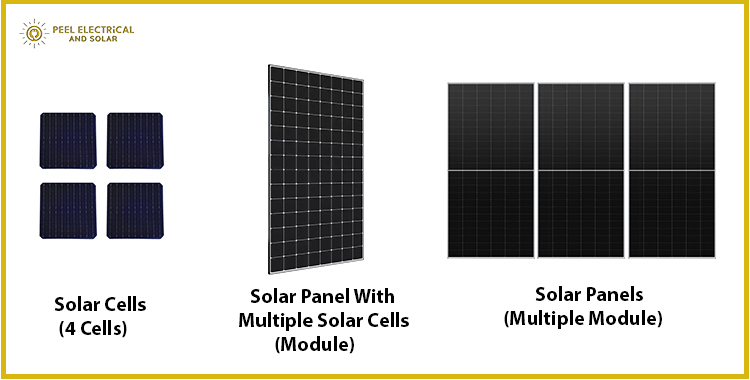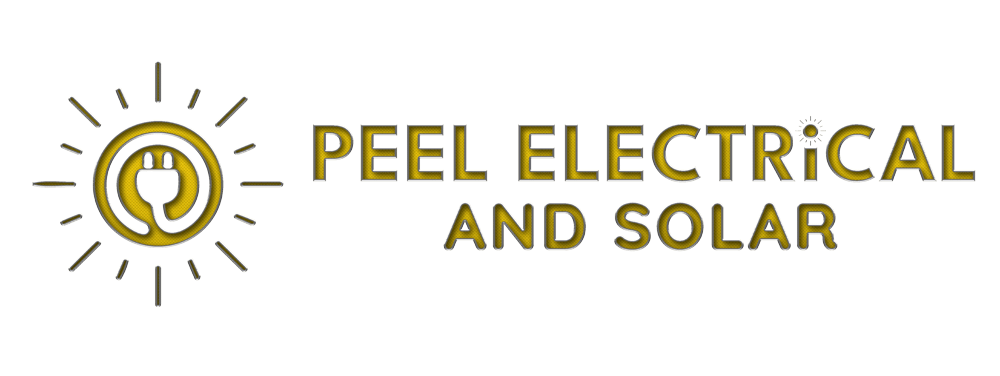Table of Contents
What is a Solar Panel?
A solar panel, also known as a photovoltaic (PV) panel is a device that converts sunlight into electricity. It’s made up of numerous photovoltaic (PV) cells that capture the sun’s energy and use it to generate electricity.

How Solar Panels Work?
Solar panels are made up of smaller units called solar cells. The most common solar cells are made from silicon, a semiconductor that is the second most abundant element on Earth. Silicon is purified through a process involving carbon and heat. It’s then shaped into thin slices called silicon vapors, which are further cut into small cells. These cells are then assembled into panels.
A silicon solar cell uses two different layers of silicon. An n-type silicon has extra electrons, and p-type silicon has extra spaces for electrons, called holes. Where the two types of silicon meet, electrons can wander across the p/n junction, leaving a positive charge on one side and creating negative charge on the other. By combining positive and negative silicon layers, a P-N junction is formed, allowing the flow of electric current. When sunlight strikes this junction, electrons are released, creating a flow of electricity. This process enables solar cells to convert sunlight into usable electricity.
Why are Solar Panels good? Solar Panel Benefits
Here are some of the key benefits of solar panels:
Clean and Renewable Energy: Solar panels use sunlight, a clean and abundant resource, to generate electricity. This reduces reliance on fossil fuels.
Reduced Electricity Bills: By generating your own electricity, you can significantly lower your dependence on the grid and potentially save money on your electricity bills.
Increased Home Value: Homes with solar panels are often seen as more attractive to potential buyers, potentially increasing your home’s value.
Government Incentives: Many governments offer financial incentives like tax credits or rebates to encourage solar panel installation.
Silent Operation: Solar panels operate silently, unlike generators or other power sources that can create noise pollution.
Energy Independence: By generating your own electricity, you gain a degree of independence from the fluctuations of the electricity grid and rising electricity costs.
Improved air quality: By reducing reliance on fossil fuels, solar energy helps improve air quality by lowering harmful emissions.
Solar Panels Size
There are two common solar panel types based on the number of cells they contain: 60-cell and 72-cell panels.
Cell Count: As the names suggest, 60-cell panels have 60 photovoltaic cells, while 72-cell panels have 72 cells.
Size: Due to the additional cells, 72-cell panels are typically larger than 60-cell panels. They are roughly a foot taller.
Power Output: Generally, 72-cell panels have a higher power output compared to 60-cell panels because of the extra cells capturing more sunlight. However, this isn’t always a guarantee. The efficiency of the individual cells also plays a role.
60-cell panels: These are popular for residential rooftop installations due to their smaller size and potentially lower cost per panel. They can be easier to fit on roofs with limited space.
72-cell panels: These are often used in commercial solar installations where there’s more space available. Their higher power output can be beneficial for generating more electricity on larger rooftops.
How efficient are solar panels, efficiency of solar panels
Solar panels come in various types, each with different efficiency levels and characteristics. The efficiency of a solar panel refers to the percentage of sunlight it can convert into usable electricity.
Top 10 Most Efficiency Solar Panels in Australia (2024)
| Manufacturer | Efficiency |
|---|---|
| REC Alpha Pure Series | Up to 22.3% |
| Q.PEAK DUO BLK ML-G10+ | Up to 20.9% |
| SunPower Maxeon | Up to 22.6% |
| Longi Hi-MO7 | Up to 22.6% |
| Canadian Solar TOPHiKu6 | Up to 23.0% |
| TrinaSolar Vertex S | Up to 21.8% |
| Jinko Tiger Neo (N-Type) | Up to 25.1% |
| Winaico WST-NGX-D3 | Up to 22.02% |
| Solarwatt Vision Pure | Up to 22.0% |
| Hyundai UF Series | Up to 21.3% |
Types of Solar Panels
There are two main types of solar panels used for residential and commercial applications: Crystalline Silicon (c-Si) and Thin-Film.
Crystalline Silicon (c-Si) Panels
Monocrystalline silicon (mono-Si)
Polycrystalline silicon (multi-Si)
Thin-Film
Cadmium telluride (CdTe)
Amorphous silicon (a-Si)
Copper indium gallium selenide (CIGS)
Considerations Before Going Solar
Cost and financing: Solar panel systems require an upfront investment, but various financing options like loans or leases can help manage the cost.
System size and energy needs: Determine your average monthly electricity consumption to choose a solar system size that meets your energy requirements.
Roof suitability: Assess your roof’s type, direction, and shade to ensure it’s suitable for solar panel installation.
Local regulations and incentives: Research any permits required in your area and explore available government incentives or rebates that can offset the initial cost.
The Solar Panel Installation Process
The solar panel installation process typically involves these steps:
Initial Consultation: A solar panel company will assess your needs, evaluate your roof suitability, and design a customized solar energy system.
Site Assessment and System Design: A technician will visit your home to assess sun exposure, roof measurements, and potential electrical upgrades.
Permitting and Approval Process: Permits from local authorities may be required before installation can begin.
Installation of the Solar Panels: Qualified technicians will professionally mount the solar panels on your roof and connect them to your electrical system.
System Inspection and Connection to the Grid: The system will be inspected by qualified personnel, followed by connection to the grid for excess electricity production.
Exploring Different Solar Panel Options
Types: Solar panels come in various types, such as monocrystalline, polycrystalline, and thin-film, each with its own advantages and efficiency levels.
Size and dimensions: Solar panel size is typically measured in watts (W) or kilowatts (kW), indicating their power output capacity. Standard panel sizes are usually based on the number of cells (e.g., 60-cell or 72-cell panels).
Special options: Consider small solar panels for powering camping equipment or portable devices, or explore foldable and flexible solar panels for their portability and adaptability to various surfaces.
Solar Panel Maintenance
The beauty of solar panels lies in their minimal maintenance requirements.
Regular cleaning, typically a few times a year, to remove dust or debris can optimize their efficiency.
Professional cleaning services are available for hard-to-reach areas.
Finding the Perfect Fit: Solar Panel Size and Dimensions
Solar panel size and dimensions are crucial factors influencing your system’s overall power output. Several factors determine the ideal size for your home:
Energy Consumption: Understanding your average electricity usage helps determine the size needed to meet your energy needs.
Roof Size and Layout: The available space on your roof dictates the number of panels you can install.
Sun Exposure: Locations with ample direct sunlight throughout the day allow for smaller systems compared to areas with less sun exposure.
Beyond the Roof: Portable Solar Panels and Camping
Solar power isn’t limited to rooftops.
These are compact and versatile options for powering devices like phones, laptops, or small appliances while camping or traveling.
Portable solar panels offer a convenient solution for off-grid adventures or emergency power backup.
Folding and flexible solar panels provide portability and versatility for camping, RV trips, or charging devices on the go.
Powering Your System: Solar Panel Battery and Inverter
A solar panel system typically includes these two key components:
Solar Panel Battery: Stores excess solar energy generated during the day for use at night or during peak grid hours. (Optional, depending on your system design)
Solar Panel Inverter: Converts the direct current (DC) electricity produced by the panels into usable alternating current (AC) electricity for your home appliances.
Choose between string inverters, which handle the entire system’s DC-AC conversion, or microinverters, which convert DC to AC at each individual panel, offering better shade tolerance and individual panel monitoring.
Harnessing the Sun's Potential: Solar Panel Efficiency
Solar panel efficiency refers to the percentage of sunlight converted into electricity.
Higher efficiency panels generate more electricity per square foot of space, but may come at a premium cost.
Going Green and Saving Money: Solar Panel Cost
The initial cost of solar panel installation can be a significant upfront investment. However, consider these factors:
Government Incentives and Rebates: Many regions offer financial incentives to promote solar adoption. Research available programs to see if you qualify for cost reductions.
Long-Term Savings on Electricity Bills: Solar panels significantly reduce your reliance on the grid, leading to substantial savings over time.
Increased Home Value: Studies show homes with solar panels tend to sell faster and for a higher price.
Solar Panel Recycling
As the solar industry grows, responsible recycling of used solar panels is becoming increasingly important.
At the end of their lifespan (typically 25+ years), solar panels can be recycled responsibly to minimize environmental impact.
Finding the Right Partner: Solar Panel Installers
Choosing a reputable and experienced solar panel installer is crucial.
Look for companies with certifications, positive customer reviews, and a proven track record of quality installations.
Research online directories, check for certifications, and read customer reviews to find reputable installers who can design and install a system that meets your specific needs and budget.
Solar panel cleaning
Regular cleaning removes dust, debris, and bird droppings that can impact efficiency.
Use a garden hose with softened water or consult professional cleaning services if needed.
Solar panel cleaning kit
Cleaning kits typically include a soft brush, cleaning solution, squeegee, and extension pole for convenient cleaning.
Solar panel system
This typically includes the panels themselves, an inverter, a mounting system, and an optional monitoring system.
Understand how these components work together to generate, convert, and manage your solar energy.
Solar panel calculator
Online calculators can provide a preliminary estimate of potential energy production and cost savings based on your location and energy needs.
Remember, these are estimates, and consulting with qualified professionals for accurate assessments is crucial.
Solar panel brackets and mounting systems
These ensure the panels are securely mounted on your roof, considering factors like wind and snow loads.
Securely mounting the panels on your roof is essential. Different types of brackets are available to suit various roof types and wind load requirements.
Best Solar Panels In Australia In 2024
Choosing the best solar panels for home in Australia depends on several factors, including your budget, roof space, and energy needs. Here are some of the top contenders in the Australian market to get you started
SunPower Maxeon Series: These panels are known for their exceptional efficiency (up to 22.6%) and durability, even in harsh Australian conditions. They come with a 25-year warranty on power output and a 40-year warranty on product defects. However, they are also among the most expensive options on the market.
REC Alpha Pure Series: Another high-efficiency option (up to 22.3%), the REC Alpha Pure Series panels are also known for their excellent temperature coefficient, meaning they perform well even in hot weather. They come with a 25-year warranty on power output and product performance.
Longi Hi-MO Series: A great balance between efficiency (up to 22.6%) and affordability, the Longi Hi-MO Series panels are a popular choice for Australian homes. They come with a 12-year warranty on product workmanship and a 30-year warranty on power output.
